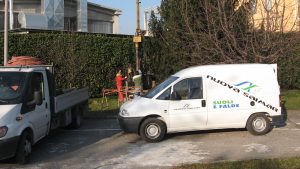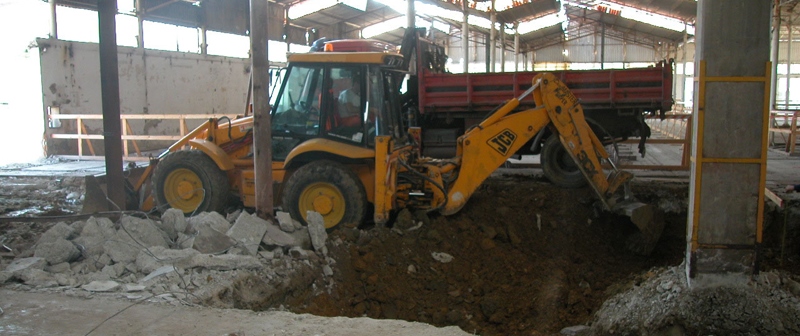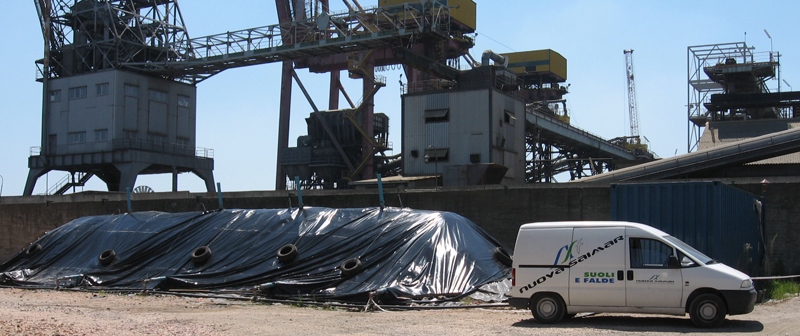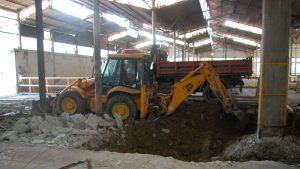Legislative Decree 22, which became effective on 5th February 1997, followed by Ministerial Decree 471 on 25th October 1999, regulated the development of environmental activity, defining the “criteria, procedures and methods for containment, remediation and environmental recovery of polluted areas”. They also highlighted the importance of the environment in terms of ecological protection, the reclamation of abandoned areas and sustainable economic development.
The recent Legislative Decree 152 dated 3rd April 2006 has reorganised, integrated and updated the whole environmental standards system, bringing together regulations regarding emissions, water discharge, waste management, contaminated sites remediation, water bodies and environmental damage, confirming the government’s awareness of environmental issues.
Thanks to its well-established experience in site remediation, through its work for multinational companies (in the industrial chemical, ceramics and paint industries) and with the main Italian and multinational oil companies throughout Italy, as well as coordinating remediation projects with local controlling Public Agencies in different parts of Italy (as per Ministerial Decree 471 dated 25th October 1999 and then Legislative Decree 152 dated 3rd April 2006), Nuova Saimar S.r.l. offers a range of specific services for contaminated site management, conforming to current regulations and official procedures which are now almost universally recognised.
A project is generally divided into the following phases:
- Site Assessments
- Designing a conceptual model and application of risk analysis. Modelling
- Drawing up and carrying out of pilot tests
- Design and Installation of in situ containment or Remediation Systems
- Operation and Maintenance (O&M) of the installations
How we work
Engineering and Consulting
Site activities are supported by the followings technical services:
-
Consultancy Service for technical and regulations advice should Legislative Decree 152/06 come into force and assistance with Authorities Meetings.
-
Consultancy service for suitable remediation technology selection
-
Field data processing and technical drawings processing such as stratigraphycal drilling logs made by environmental geologists, contaminants mapping, groundwater gradient maps, etc., with software such as Surfer
-
Pumping tests processing with dedicated software such as AQUIFER WIN 32
-
Conceptual models processing
-
Risk Analysis processing to to determine public health safety level and the specific risk threshold concentrations of the site, to assess the effective level of contamination. Analysis made with recognised software such as RISC, ROME and GIUDITTA
-
Groundwater Risk analysis processing with recognized software such as RAM and ChristalBall
-
Two- and three-dimensional simulation models processing, using universally recognised software such as AQUIFER WIN 32 (two-dimensional simulation models of groundwater flow and contaminant transport) and GROUNDWATER VISTAS (three-dimensional simulation models of groundwater flow and contaminant transport).
-
Monitoring Programme developing to check the progress of the remediation process
-
Drafting of Technical Reports including:
Geological Technical Report for Site Assessments
-
Risk analysis and simulation models
-
Notification (upon the client’s request) should Legislative Decree 152/06 come into force
-
Characterisation plans (Ministerial Decree 471/99 and Legislative Decree 152/06) or Site Assessment Plans
-
Preliminary and Executive Remediation Projects (Ministerial Decree 471/99 and Legislative Decree 152/06)
-
Final site inspections and direct tests as official final verification for the carried out remediation
Site Assessment
An appropriate site assessment may be composed by one or more of the following activities depending on site peculiarities and preliminary planning:
-
In situ site inspection to make a preliminary assessment of the site’s environmental safety situation (checking for the presence of organic vapours, the impact on wells downgradient from the spill area, etc.). Collection of bibliographical material as to the geological and hydrogeological lay-out of the site. Geomorphological survey.
-
Indirect, non-destructive assessment to define the structure of the ground and the distribution of the pollutants in the subsoil. These tests are carried out using geophysical surveys (geoelectric and georadar).
-
Direct assessment, monitoring the interstitial gases in the subsoil (soil gas survey).
-
Direct assessment using continuous core drilling to determine the stratigraphy of the ground or to identify the contaminated levels by collecting soil samples.
-
Head space analysis onto soil samples along the vertical drilling line, to determine the concentration of volatile organic compounds (VOC).
-
Monitoring wells installation, groundwater table level monitoring and pumping tests on the aquifer to determine the hydrogeological parameters (hydraulic conductivity, transmissivity, gradient).
-
Groundwater samples collection and chemical analysis.
-
Environmental assistance when underground storage tanks are removed from sites and/or sites are being dismantled/decommissioned.
-
Drawing up and carrying out of pilot tests to check the suitability of remediation technologies and to measure the containment and/or remediation systems (short- and long-term pumping tests, respirometric tests, etc.).
All site activities are directed by qualified site geologists in order to collect all data needed for the following engineering phases
The most suitable typology of site assessment to perform is identified after an adequate preliminary planning.
Spills Emergency Containment and Recovery
Nuova Saimar S.r.l. provides an emergency environmental service in order to contain and recover contaminants spilling directly or indirectly in the water (both surface water and groundwater), in the soil or wherever they may accumulate, creating potential public health and environmental hazards. Services include:
-
Containment Barriers (Booms) Installation
-
Suction or Recovery of Spilt Product with oil adsorbent powders, rugs and booms
-
Removal of Ground Surface Layer with contaminant adsorbents
-
Washing the Areas Affected by spill (Road Surfaces, Stonework, Machinery, etc) with water-based solutions and specific detergents, using high-pressure jets where necessary and collecting and disposing of the water used in the washing process
-
Installing Forced Ventilation Systems in case of explosive vapours in basements and/or underground premises in general
-
Installing Groundwater Pumping and Treating Systems and Floating Product Selective Recovery System (Scavengers, Skimmers, etc.).
The efficiency of installations is guaranteed thanks to a maintenance programme which is scheduled to specific project needs.
All actions are identified after an adequate preliminary planning performed by our qualified personnel.
.
Soil and Groundwater Remediation
A remediation or containment system is then designed and installed on the basis of the above tests and results. It is designed according to the nature and extent of the contamination, generally applying one or more of the following technologies:
-
Groundwater Recovery and Treatment Systems (Pumping & Treating Systems, Hydraulic Barriers)
-
Recovery of Free Products Floating onto Groundwater (Skimmers, Scavengers, etc.)
-
Soil Vapor Extraction Systems with Treatment of the Extracted Gas Soil Venting or Bioventing Systems
-
Soil Remediation Systems with In-Situ Biological Treatment Systems (Landfarming, Phytoremediation) and On-Site Pile Treatment (Biopiles, Biocells, etc.)
-
Soil and Groundwater Remediation with Dual Phase High Vacuum Extraction Systems, Bioslurping Systems, etc.
-
Groundwater Bioremediation Systems (Air Sparging, Biosparging, etc)
-
Groundwater Remediation Systems (Permeable Reactive Barriers, Monitored Natural Attenuation, etc)
The efficiency of installations is guaranteed thanks to a maintenance programme scheduled to specific project needs.
Furthermore, if technically and economically applicable, Nuova Saimar performs site remediation with direct mechanical removal of contaminated soil, to be transferred to authorized disposal.
All actions are identified after an adequate preliminary planning performed by our qualified personnel.
Oil Spill Emergency

Nuova Saimar offers to its Clients an Oil Spill Emergencies service all along the Italian territory, in case of environmental emergencies occuring:
- on-shore, as Gas and/or Oil Treatement Plants, Geothermal Plants, Fuel Depots, Oil Pipelines, …
- in water surfaces, from fresh water to salty water
- in wells area close to the onshore worksites
- in temporary worksites
We grant emergency safety measures after accidental contaminations, by remouving and isolating the polluting substances and by preventing the contaminants’ spreading.
On the signing of a written agreement, Nuova Saimar provides a 24/7 Oil Spill Emergencies service.




